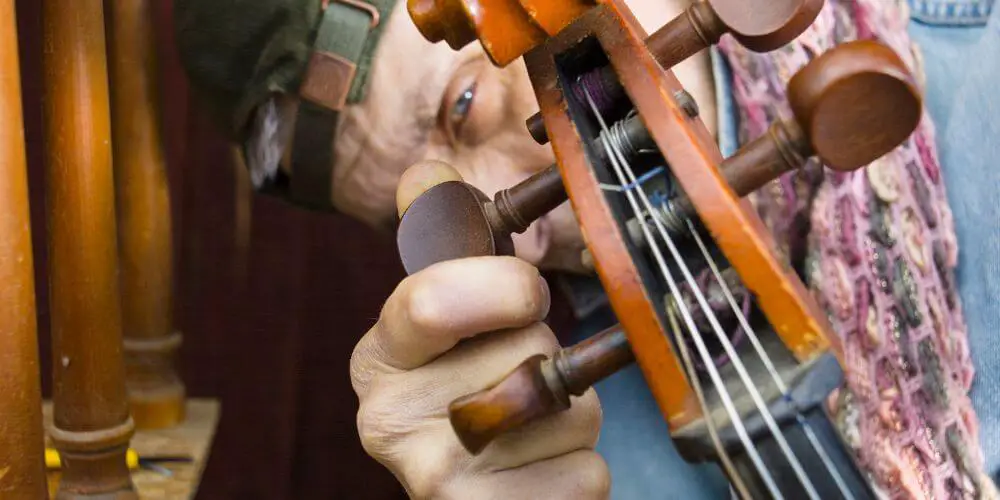Every cellist will need to learn how to tune a cello. Regardless of whether you are a beginner or a professional player, this is simply inevitable.
The cello tuning process can be lengthy and frustrating, and depending on certain environmental factors, you might have to tune your instrument more frequently than you had anticipated.
This just adds to the frustration. Not to mention the very likelihood of breaking your strings as you attempt to tune the instrument.
Well, worry not. This simple guide will help you get much better at tuning your cello.
Table of Contents
Quick Summary
- The more often you tune your cello using the tuning pegs rather than the fine tuners, the better it will stay in tune.
- Cello pegs are different from guitar pegs, so please don’t let your guitar-playing friends tune your cello for you.
- Keeping your cello in a humidity-controlled environment will help prevent plenty of tuning-related issues such as peg slips.
- Developing a better sense of pitch will make your tuning process much faster.
Cello Tuning Basics
The construction of a cello is such that four tuning pegs are located on the pegbox on the scroll and four fine tuners located on the instrument’s tailpiece. You can use both the tuning pegs and the fine tuners to change the tension of the strings, in turn changing the pitch of the strings as well.
The general rule of thumb is that minor adjustments are made using the fine tuners, whereas major adjustments where the strings are really off-pitch are made using both the finer tuners and tuning pegs.
Typically, tightening the strings increases the pitch, while loosening the strings lowers the pitch.
You need to be cautious when adjusting the string tension. This is because the cello, like many other stringed instruments, is constructed such that the tension of the strings is what secures the bridge, keeping the soundpost erect.
Typically, you tune a cello in an open strings position, that is, without any fingers touching the strings to the board.
Cello Tuning Sequences
If more than two strings need tuning, you will use the sequence A, D, G, C, starting with the highest-pitched string and working your way downwards. The A string is considered the first string on a cello, whereas the C string is the fourth string.
Step 1: Hold the cello in playing position.
Step 2: Starting with the open A string, gently pluck the string to generate a tone.
Step 3: Gradually tighten or loosen the corresponding tuning peg until the A string is close to the correct pitch.
Note: Don’t bother getting a perfect pitch at this time. The tuning of any string impacts the tuning of the other strings, so there will be multiple adjustments as you go along. Your goal should be to get as close as possible to the desired pitch.
Step 4: Continue the same procedure with the other strings till you get to the last C string.
Step 5: Once you’ve tuned all the strings as best as you can, check the bridge alignment.
Note: Tightening the strings too much can apply forward pressure on the bridge, causing it to lean, so you should check to ensure that this isn’t the case. The bridge should be at a 90° angle to the belly of the instrument.
Step 6: Going back to the A string, repeat the process using smaller and smaller adjustments to progressively tighten all strings bringing them much closer to the desired pitch.
Note: You should now be within one note of the perfect pitch.
Step 7: Using the fine tuners, go back to each string, making the final adjustment to achieve the perfect pitch.
Note: Be careful not to tighten your fine tuners all the way, as extreme tightening could dent the soundboard on some cellos.
Methods To Use When Tuning Your Cello
Using Tuning Pegs
On a cello, we adjust the tension of the strings using either the pegs or the fine tuners, which in turn changes the pitch of the strings.
Tightening the pegs tightens the strings, thereby increasing the pitch, while loosening the pegs loosens the strings, in turn lowering the pitch.
Keep in mind that you should never turn the pegs too quickly or too far; otherwise, you might cause your stings to snap.
When using the tuning pegs, a good rule of thumb is to always start by releasing the peg towards you before tuning the peg away from you. This is because you are very likely to over-turn the peg, creating too much tension and causing the string to snap.
The correct way to handle these pegs while tuning is to simultaneously push them in while turning them. This way, the pegs stick into the pegbox, allowing the cello to stay in tune rather than loosening as you play.
That being said, the best pegs should neither be too tight nor slippery. Having your instrument set up by a specialist will help to ensure your pegs have smooth action.
Using Fine Tuners
Fine tuners are the four small metal screws mounted at the tailpiece of the cello, and when screwed, they work by bringing the metal attachments closer together.
A good rule of thumb is to use fine tuners only when making changes of approximately one note which is ideally a semitone or a half-step.
You don’t make large adjustments using the tuners because this will require too much turning, causing the tuner to be significantly out of line with the other fine tuners. So you always start with the pegs, then the fine tuners come in at the very end.
Using An Electronic Tuner
An electronic tuner, also known as a chromatic or digital tuner, helps significantly in the tuning process by allowing you to see how the note of a string changes as you turn the pegs. This tuner will indicate whether you are sharp, flat, or on the perfect pitch.
As the cellist advances and their pitch awareness develops, they can then be more confident and comfortable tuning the cello using harmonics or tuning forks.
While using a digital cello tuner, the thing to keep in mind is to be mindful of their accuracy level because some tuners will measure pitch with more precision than others.
Tuning A Cello By Ear
Advanced cellists have a well-trained ear that detects subtle differences in pitch. This naturally happens over time and practice, as the player gains more experience with music.
One way to go about this would be to get a reference tone for comparison tuning, and this can be achieved using a pitch pipe, tuning fork, or another instrument such as the piano.
Another way would simply be to tune the cello without an external source. This requires having a perfectly attuned ear, whereby you use one string as a reference point for tuning another string.
Cello Tuning Tips
1. Loosen your fine tuners before you begin the tuning process.
2. Never loosen or remove all your cello strings at once. Instead, work on a single string at a time. This is because insufficient string tension will cause your bridge and soundpost to collapse, and fixing this will be quite a costly affair.
3. High temperatures cause the strings to become flat, whereas lower temperatures can cause the strings to go sharp. Keep this in mind as you tune your cello.
4. A cello peg is not like a guitar peg. In this instance, move the tuning peg about a quarter-turn at a time, or else you risk breaking a string.
5. Another thing to remember is that the tuning pegs are conical-shaped. As such, to ensure the peg stays in place, you will need to gently push it in as you turn it.
6. Regularly fine-tune your cello.
How To Tune A Cello FAQs
What Is The Standard Tuning For A Cello?
The standard tuning for a cello is C-G-D-A, from the lowest string to the highest.
The C string is tuned to the note C2, two octaves below middle C. The G string is tuned to G2, the D string is tuned to the note D3, and the A string is tuned to the pitch A3.
What Frequency Should I Tune My Cello To?
The frequency you should tune your cello to is 440 Hz because this is the standard pitch frequency tuning for the cello’s A string.
Because we typically tune the cello’s A string first, it is typical to tune this string at 440 Hz, then progressively move to the other strings.
Is It Hard To Tune A Cello?
Yes, it can be pretty hard to tune a cello, especially if this is your first time doing so.
Tuning a cello requires a lot of patience and effort, or you will find the process quite frustrating, especially if you aren’t using a chromatic tuner.
The good news is that with time, once you get good at knowing which string is out of tune and which direction to turn the tuning pegs and fine tuners, the tuning process will become much easier.
Conclusion
Tuning your cello correctly is all about having a ton of patience and putting in plenty of effort in the endeavour.
Initially, getting your cello in tune may appear pretty hard and almost impossible. With time and practice, though, the skill will come to you rather effortlessly.
So embrace the process, and take it as an opportunity to hone your inner hearing. You’ll eventually get the hang of it.





